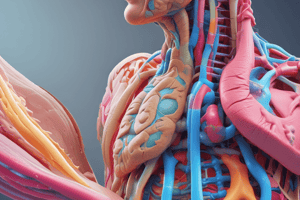Podcast
Questions and Answers
What is the main function of the gastrointestinal tract?
What is the main function of the gastrointestinal tract?
- Digestion and absorption of food (correct)
- Pumping blood to all body parts
- Producing hormones
- Regulating body temperature
What is the function of Brunner's glands in the small intestine?
What is the function of Brunner's glands in the small intestine?
- Secrete enzymes for protein digestion
- Increase the surface area for absorption
- Secrete mucus and bicarbonate to neutralize acidic chyme (correct)
- Absorb water and electrolytes
Which structure in the GIT uses peristalsis for food transport?
Which structure in the GIT uses peristalsis for food transport?
- Esophagus (correct)
- Large Intestine
- Small Intestine
- Stomach
Which layer of the gastrointestinal tract is composed of smooth muscle and aids in food movement?
Which layer of the gastrointestinal tract is composed of smooth muscle and aids in food movement?
What type of cells line the esophagus?
What type of cells line the esophagus?
What is the role of the microbiota in the gastrointestinal tract?
What is the role of the microbiota in the gastrointestinal tract?
Which organ secretes hydrochloric acid and digestive enzymes in the GIT?
Which organ secretes hydrochloric acid and digestive enzymes in the GIT?
Which part of the large intestine absorbs water and electrolytes?
Which part of the large intestine absorbs water and electrolytes?
What is the name of the layer in the stomach that protects it from the acidic environment?
What is the name of the layer in the stomach that protects it from the acidic environment?
What are villi in the small intestine responsible for?
What are villi in the small intestine responsible for?
Which layer of the gastrointestinal tract contains glands that secrete mucus and fluids?
Which layer of the gastrointestinal tract contains glands that secrete mucus and fluids?
Which region of the GIT is primarily responsible for nutrient absorption?
Which region of the GIT is primarily responsible for nutrient absorption?
Flashcards are hidden until you start studying
Study Notes
Anatomy of the Gastrointestinal Tract
The gastrointestinal tract (GIT) is a complex, quadruple-layered structure that plays a crucial role in the digestion and absorption of food, as well as the elimination of waste products. It is lined with a layer of epithelial cells and an extracellular matrix (ECM)-rich layer called the lamina propria. Additionally, it hosts an abundant and diverse microbiota that influences host-microbial interactions and supports host mucosal immunity and intestinal barrier function.
Structure of the GIT
The gastrointestinal tract is divided into four parts: the esophagus, stomach, small intestine, and large intestine. Each of these regions has specific functions in the digestive process.
-
Esophagus: This is a muscular tube that connects the mouth to the stomach. It is lined with squamous epithelial cells and has a stratified, columnar structure. The esophagus uses peristalsis to transport food towards the stomach.
-
Stomach: The stomach is a J-shaped organ that secretes hydrochloric acid and digestive enzymes to break down food. It has a glandular mucosa with pits and glands called gastric pits. The stomach also has a mucus-secreting layer, the gastric mucosa, which protects the stomach lining from the acidic environment.
-
Small Intestine: The small intestine is a long, coiled tube that is responsible for the majority of nutrient absorption. It has a villous structure, with finger-like projections called villi that increase the surface area for absorption. The small intestine also has glands called Brunner's glands, which secrete mucus and bicarbonate to neutralize the acidic chyme.
-
Large Intestine: The large intestine, also known as the colon, is a long tube that absorbs water and electrolytes from the digestive contents. It has a large diameter and a smooth, non-villous surface. The large intestine is divided into four parts: the cecum, colon, rectum, and anus. It ends with the anus, which is the opening for the elimination of waste products.
Layers of the GIT
The gastrointestinal tract has four layers: mucosa, submucosa, muscularis mucosa, and serosa.
-
Mucosa: This is the innermost layer of the GIT, composed of epithelial cells and the ECM-rich lamina propria. It also contains glands that secrete mucus and fluids.
-
Submucosa: This layer is rich in blood vessels, lymphatics, and nerves. It provides nutrients and oxygen to the mucosa and helps in the absorption of nutrients.
-
Muscularis Mucosa: This layer is composed of smooth muscle and helps in the movement of food through the GIT.
-
Serosa: This is the outermost layer of the GIT, composed of connective tissue and fat. It protects the GIT from external damage and provides support.
The Role of Microbiota in the GIT
The gastrointestinal tract contains a diverse microbiota, which plays a significant role in maintaining a healthy gut. It influences host-microbial interactions and supports host mucosal immunity and intestinal barrier function. The microbiota also helps in the digestion of complex carbohydrates and the synthesis of certain vitamins.
Gastrointestinal Models
Scientists have developed various in vitro and in vivo models to study the gastrointestinal tract and its functions. These models include less complex traditional models, standard 2D models, and newer 3D models like organoids, enteroids, and organ-on-a-chip. The choice of model depends on the research question.
In vitro models are particularly useful for studying the interactions between probiotics and pathogens, as they are ethically superior, faster, and less expensive than in vivo models. They are also suitable for studying the effects of diet and other environmental factors on the gut microbiota.
In conclusion, the gastrointestinal tract is a complex system that plays a vital role in digestion, absorption, and elimination. Its structure and functions are supported by a diverse microbiota, which influences host-microbial interactions and supports host mucosal immunity and intestinal barrier function. The development of gastrointestinal models has facilitated research into the mechanisms of the gastrointestinal system and its interactions with probiotics and pathogens.
Studying That Suits You
Use AI to generate personalized quizzes and flashcards to suit your learning preferences.




